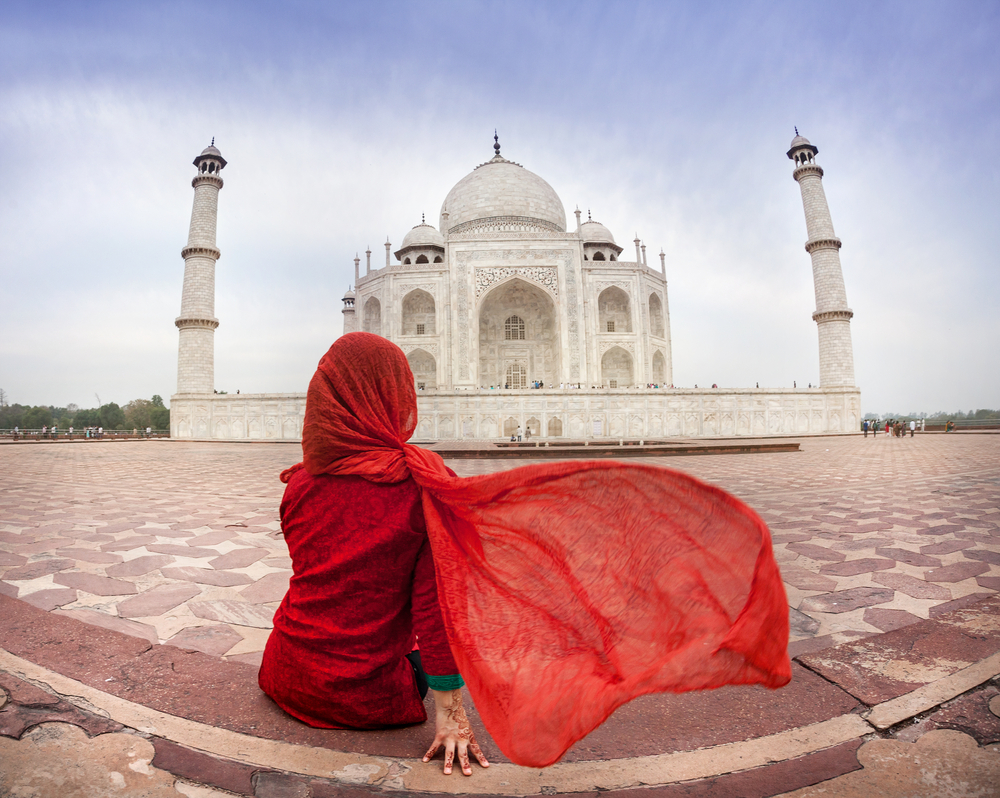Get ready to embark on a fascinating journey through the top heritage sites of India. There, ancient whispers of the past come alive. India, famous for its rich cultural heritage, is a treasure trove of historical gems. They offer a glimpse into the country’s captivating history and diverse traditions.
Now, why should we care about Heritage Sites of India? Well, they play a crucial role in preserving our history and culture. These sites are like time capsules, preserving the stories, customs, and artistry of generations long gone. They give us a chance to connect with our roots.
Think about it – each of the Heritage Sites of India holds within its walls the memories and experiences of countless individuals who once walked those paths, built those structures, and shaped the destiny of their land. It’s truly remarkable how these sites allow us to step into the shoes of our ancestors. And also learn from their achievements, struggles, and triumphs.
The Golden Triangle
The Golden Triangle region encompasses the cities of Delhi, Agra, and Jaipur. It is a fascinating tapestry of history, culture, and architectural wonders.
Taj Mahal in Agra
The Taj Mahal in Agra is an awe-inspiring monument that holds immense historical significance. It is one of the world’s greatest architectural marvels. Built in the 17th century by Emperor Shah Jahan as a mausoleum for his beloved wife, Mumtaz Mahal, it stands as a testament to their eternal love. This UNESCO World Heritage site is famous for its exquisite beauty and intricate craftsmanship. Its gleaming white marble facade, adorned with intricate inlay work and delicate carvings, is a sight to behold.
Beyond its architectural splendor, the Taj Mahal carries a poignant love story that has captured the hearts of people for centuries. Emperor Shah Jahan was deeply grief-stricken by the death of his wife, Mumtaz Mahal, and commissioned this grand mausoleum as a symbol of their eternal love. It took over 20,000 artisans and laborers almost two decades to complete this monumental masterpiece.
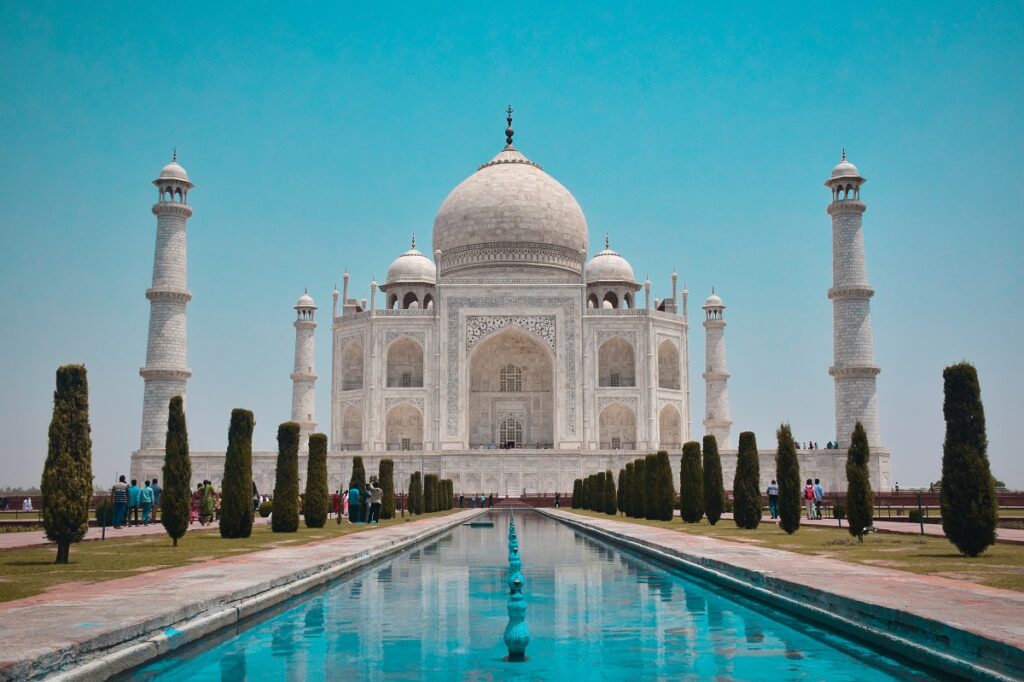
Red Fort in Delhi
The Red Fort, located in Delhi, is a monumental structure that holds great historical significance and boasts remarkable architectural features. Constructed during the 17th century by Emperor Shah Jahan, it served as the main residence of the Mughal emperors for nearly 200 years. The fort’s red sandstone walls, stretching over two kilometers, enclose an impressive complex of palaces, gardens, and audience halls. Its intricate ornamentation, including delicate marble inlays and detailed carvings, showcases the exquisite craftsmanship of the Mughal era.
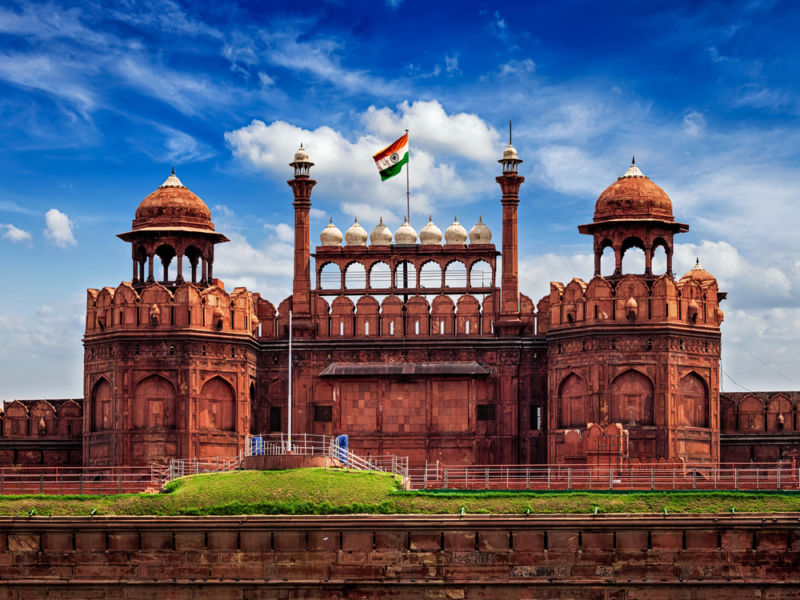
Hawa Mahal in Jaipur
The Hawa Mahal, located in Jaipur, is a mesmerizing architectural gem. It showcases a unique blend of intricate craftsmanship and cultural significance. Known as the “Palace of Winds,” it is a stunning five-story structure made of red and pink sandstone. What sets it apart is its intricate honeycomb-like façade. It is adorned with numerous small windows and balconies, allowing cool breezes to flow through and providing a respite from the scorching Rajasthan heat. The delicate lattice work and ornate detailing make the Hawa Mahal a true architectural marvel.
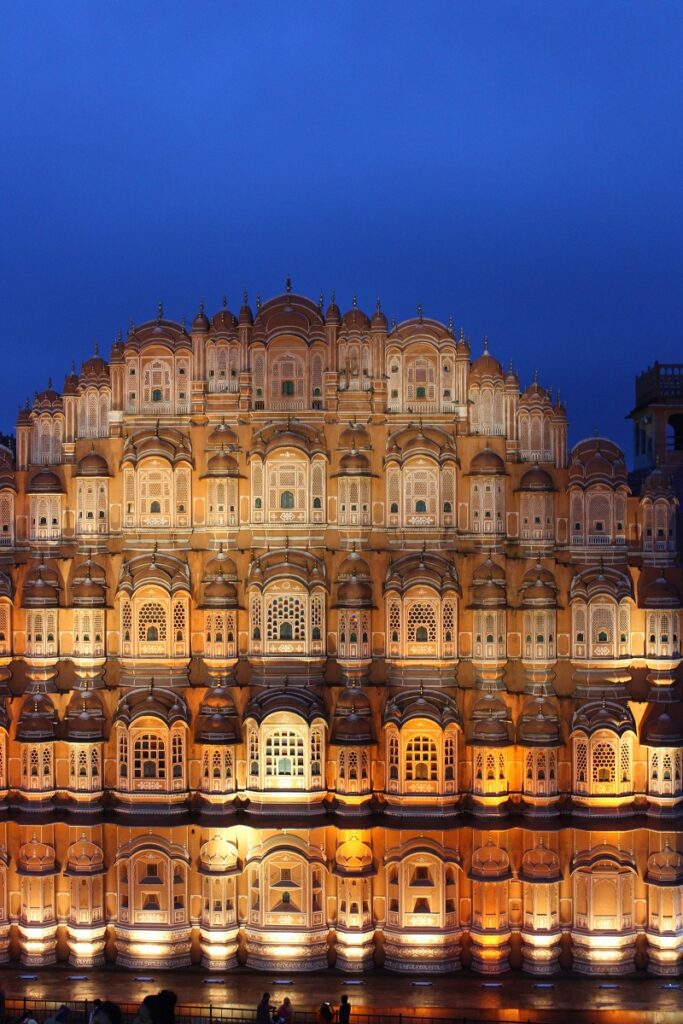
South India’s Temple Splendors
Welcome to the enchanting world of South India’s rich temple heritage, where spirituality and architectural marvels intertwine. This region of India is famous for its awe-inspiring temples, each telling a unique story of devotion and artistry. From the ancient Dravidian-style temples with towering gopurams (entrance towers). To the intricately carved sculptures and vibrant frescoes adorning their walls. South India’s temple heritage is a testament to the deep-rooted traditions and cultural splendor of this land.
Meenakshi Temple in Madurai
The Meenakshi Temple in Madurai stands as a testament to South India’s architectural brilliance and religious significance. This ancient temple complex, dedicated to the goddess Meenakshi (an incarnation of Parvati) and her consort Lord Sundareswarar (an incarnation of Lord Shiva), is a vibrant hub of spirituality and devotion. The temple’s towering gopurams, with their colorful sculptures depicting gods, goddesses, and mythical creatures, are a visual spectacle that leaves visitors in awe.
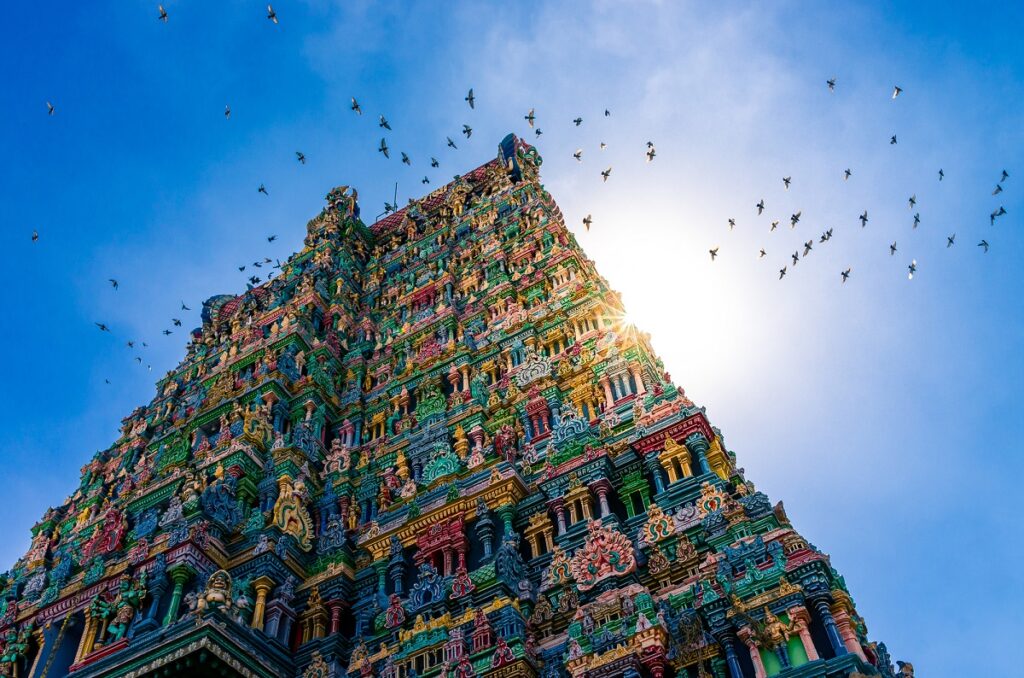
Brihadeeswarar Temple in Thanjavur
The Brihadeeswarar Temple in Thanjavur is one of the Heritage Sites of India that stands as a magnificent testament to South India’s rich cultural heritage and architectural prowess. The majestic architecture of the Brihadeeswarar Temple, with its finely detailed stone carvings, intricately carved pillars, and spacious courtyards, leaves visitors in awe of the skill and craftsmanship of the Chola artisans.
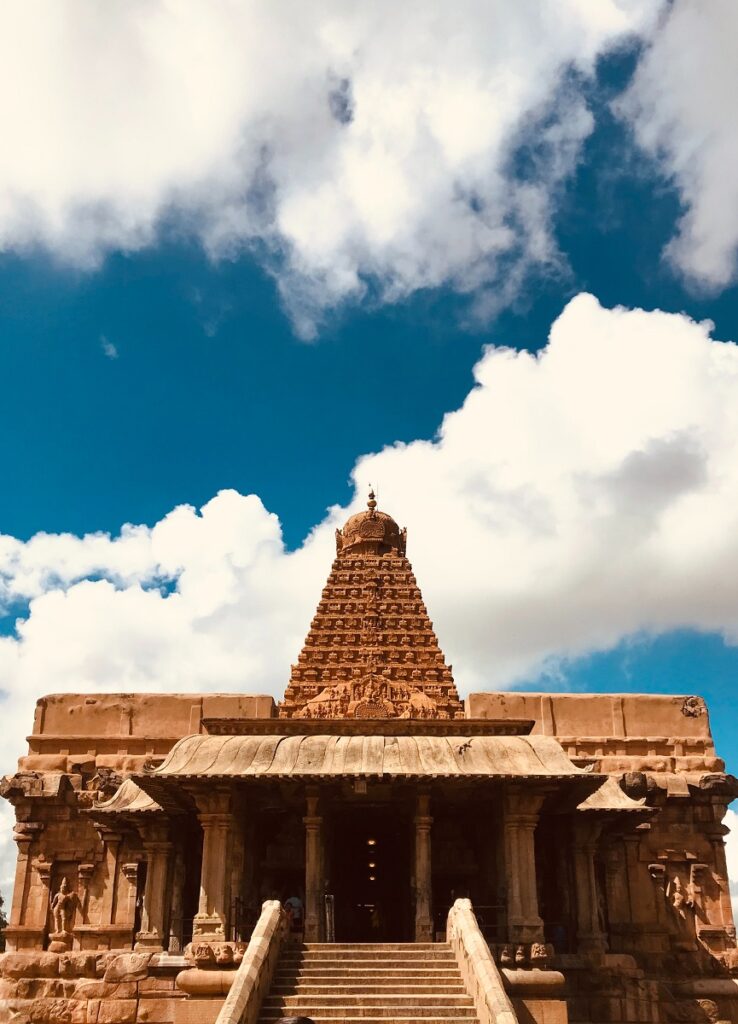
Hampi – The Forgotten City
Hampi, known as the Forgotten City, is a captivating one of the UNESCO Heritage Sites of India. It takes you back in time to the glorious era of the Vijayanagara Empire. Scattered across a vast landscape in Karnataka, India, the ruins of Hampi bear witness to the grandeur and prosperity of the empire that once flourished here. The city was the capital of the Vijayanagara Empire from the 14th to the 16th century. And now its remnants offer a glimpse into the rich cultural and architectural heritage of that era. The ruins include impressive temples, royal complexes, markets, and water structures. They showcase the artistic mastery and engineering prowess of the Vijayanagara civilization.
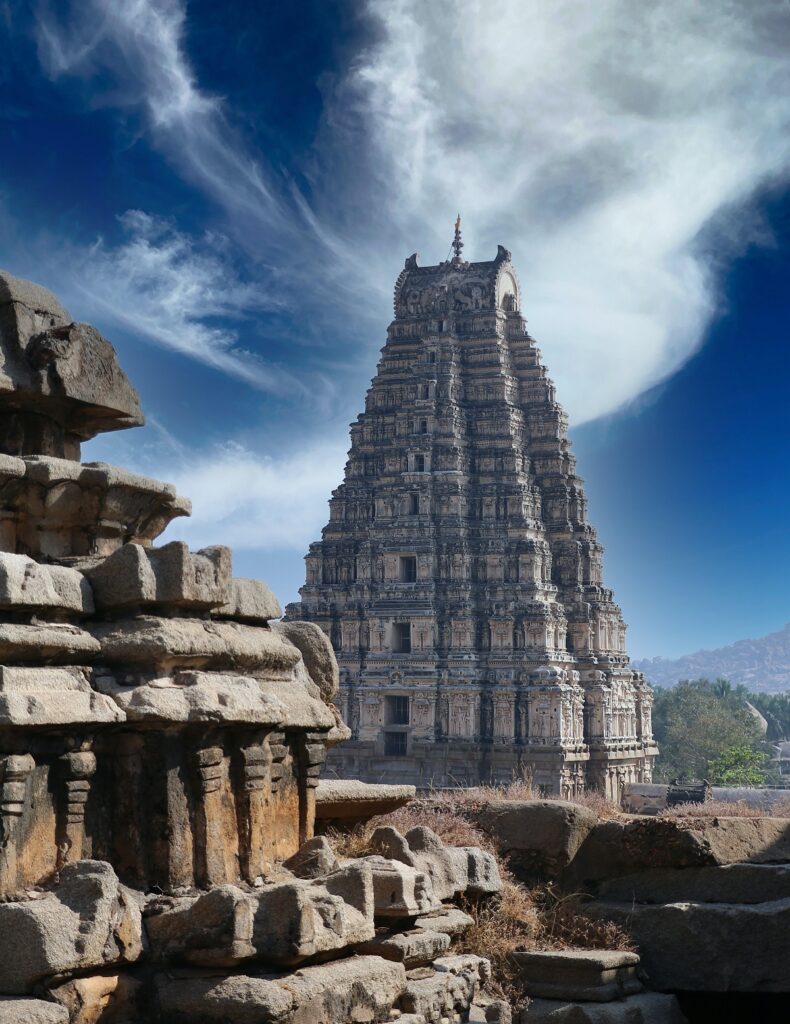
Splendors of Rajasthan
Rajasthan, the land of kings, is famous for its rich royal heritage and architectural wonders that transport visitors to a bygone era of opulence and grandeur. The state’s majestic palaces, forts, and havelis stand as testaments to the valor and artistic brilliance of the Rajput rulers.
Mehrangarh Fort in Jodhpur
Perched on a rocky hill in Jodhpur, Mehrangarh Fort is a captivating architectural wonder. It offers a glimpse into the grandeur and valor of Rajasthan’s royal past. The fort’s majestic walls and imposing gateways lead to a sprawling complex that houses magnificent palaces, courtyards, and museums. The palaces within the fort, such as the Moti Mahal (Pearl Palace) and Phool Mahal (Flower Palace), boast intricate carvings, ornate ceilings, and opulent interiors that showcase the exquisite craftsmanship of the bygone era.

City Palace in Udaipur
On the banks of Lake Pichola, the City Palace in Udaipur is a picturesque palace complex that exudes elegance and charm. This architectural gem showcases a harmonious blend of Rajput and Mughal influences. With its ornate balconies, delicate arches, and beautifully landscaped gardens. The City Palace is not only a testament to the grandeur of Udaipur’s royal heritage but also offers a visual feast of tranquil lake vistas that add to the enchanting ambiance of this regal destination.

Jaisalmer Fort – The Golden Fortress
Rising like a golden mirage from the Thar Desert, Jaisalmer Fort, also known as the Golden Fortress, is a unique architectural marvel that holds immense cultural importance. This massive sandstone fort stands tall atop Trikuta Hill, offering panoramic views of the surrounding desert landscape. Within its fortified walls, visitors can explore a labyrinth of narrow lanes, exquisite havelis (traditional mansions), and vibrant markets.

The Majestic Caves
India is home to a remarkable collection of ancient rock-cut caves, showcasing the country’s rich cultural and religious history. These majestic caves, hewn out of solid rock, serve as architectural marvels and spiritual sanctuaries. From the renowned Ajanta and Ellora Caves in Maharashtra to the Elephanta Caves in Mumbai. These sites are adorned with intricate carvings, elaborate sculptures, and mesmerizing paintings that depict mythological tales and religious themes. Exploring these caves takes visitors on a journey back in time, unraveling the mysteries of ancient civilizations and offering a glimpse into the artistic and spiritual pursuits of bygone eras.
Ajanta Caves in Maharashtra
The Ajanta Caves in Maharashtra one of the UNESCO Heritage Sites of India, is a treasure trove of ancient Buddhist art and architecture. Carved into the rocky cliffs of the Waghora River, these caves showcase a magnificent collection of paintings and sculptures dating back to the 2nd century BCE. The sculptures, intricately carved and meticulously preserved, depict Buddha, bodhisattvas, and various other deities. Exploring the Ajanta Caves is a journey through time, where visitors can marvel at the artistic brilliance and spiritual devotion of the ancient craftsmen who created these masterpieces.
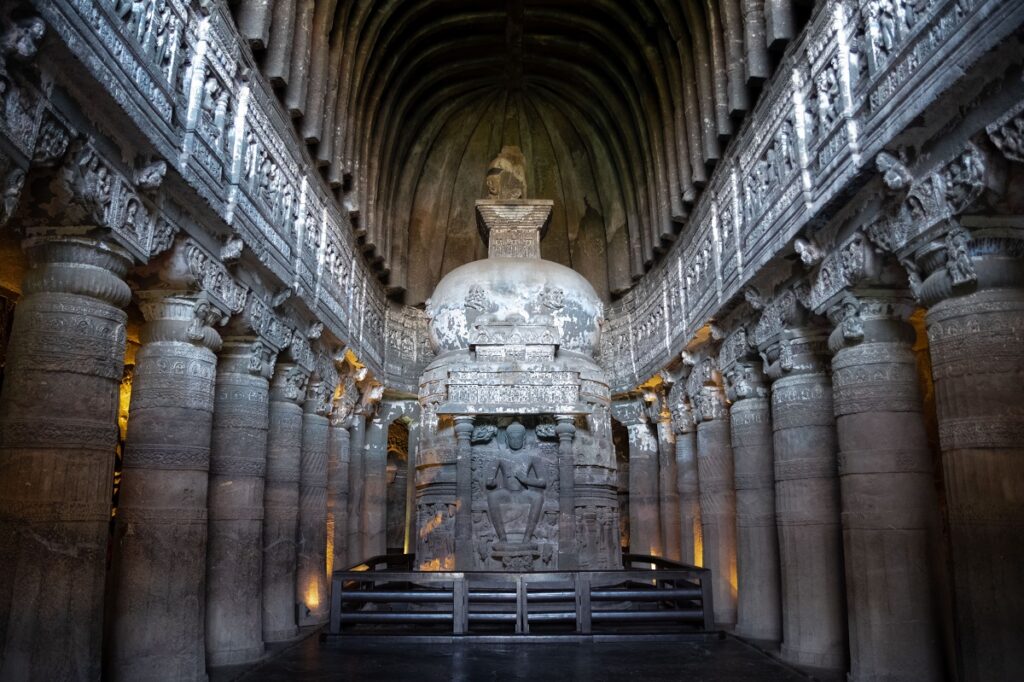
Ellora Caves in Maharashtra
The Ellora Caves in Maharashtra form a sprawling cave complex that houses a remarkable amalgamation of Hindu, Buddhist, and Jain temples, showcasing the rich religious diversity of ancient India. Carved meticulously into the Charanandri Hills, the caves boast an astonishing level of detail and craftsmanship. From the awe-inspiring Kailasa Temple, dedicated to Lord Shiva, to the intricate carvings of Buddha and the magnificent Jain temples, the Ellora Caves offer a captivating journey through the religious and architectural heritage of India. The caves hold great religious significance for followers of these three faiths and serve as a testament to the harmonious coexistence of different religions in ancient India.

Elephanta Caves in Mumbai
The Elephanta Caves, located on Elephanta Island in Mumbai, is a captivating testament to India’s rich cultural and religious heritage. The intricately carved sculptures within the caves depict various forms of Lord Shiva, including the iconic Maheshmurti, a three-faced representation of the deity. The attention to detail and artistry exhibited in the sculptures is awe-inspiring, with each intricately carved figure evoking a sense of devotion and wonder. The caves’ spiritual ambiance, combined with the natural beauty of the island, creates a serene and introspective atmosphere that allows visitors to connect with the divine and experience the timeless allure of Indian mythology and spirituality.
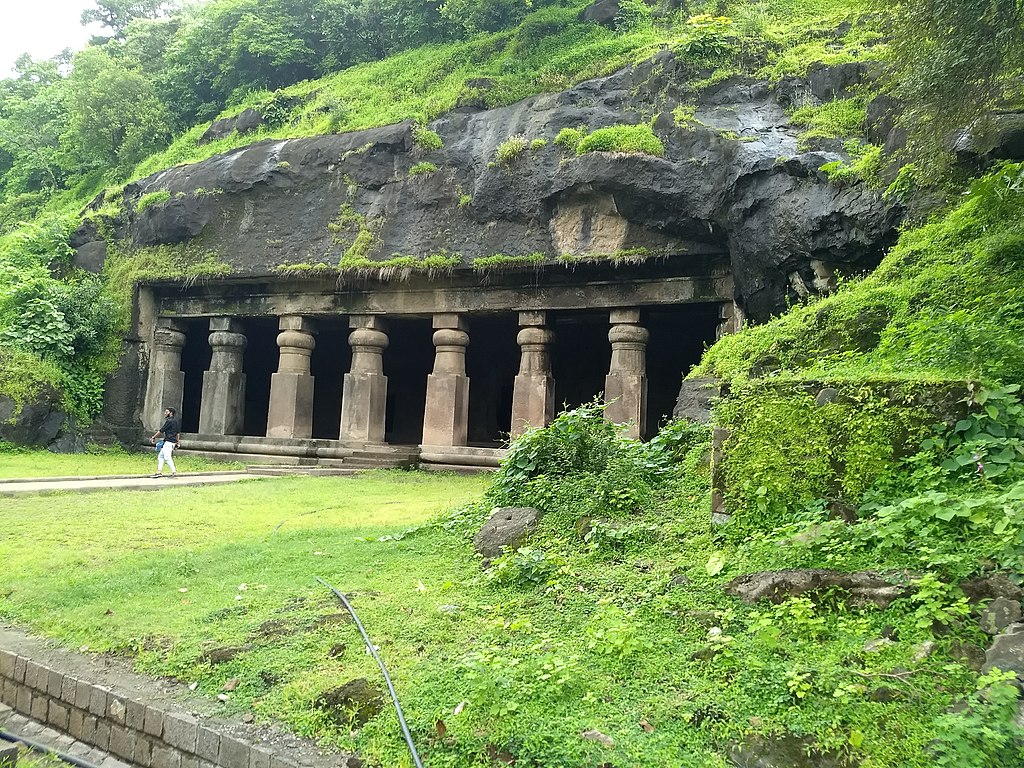
The Serenity of Varanasi
Varanasi, also known as Kashi, is a city that exudes an unparalleled sense of serenity. Nestled along the sacred Ganges River in Uttar Pradesh, India, it is considered one of the oldest living cities in the world. Varanasi is a place where spirituality and devotion intertwine, and the ethereal atmosphere permeates every corner of the city. The ghats, the steps leading down to the river, witness rituals and ceremonies that connect people to their religious beliefs. And offer a profound sense of peace. Varanasi’s timeless charm and its ability to transport visitors to a realm of inner peace make it a place of profound serenity.
Dashashwamedh Ghat
Dashashwamedh Ghat, one of the most significant and vibrant ghats in Varanasi, holds immense cultural and religious importance. According to Hindu mythology, Lord Brahma performed the Dashashwamedh Yajna (a grand ritual) at this very spot. It is believed that taking a dip in the sacred Ganges River at Dashashwamedh Ghat cleanses one’s sins and paves the way for spiritual liberation. The highlight of this ghat is the enchanting Ganga Aarti, a captivating ritual performed every evening. Devotees and visitors gather to witness the ceremony as priests offer prayers to the river, accompanied by chanting, music, and the mesmerizing spectacle of lamps being lit and swayed in a rhythmic motion.

Sarnath – The Place of Buddha’s First Sermon
Sarnath, often referred to as the Place of Buddha’s First Sermon, holds immense historical and religious significance in Buddhism. This sacred site, located near Varanasi in Uttar Pradesh, marks the spot where Lord Buddha delivered his first sermon after attaining enlightenment. Additionally, the Sarnath Museum houses a remarkable collection of Buddhist artifacts, including sculptures, relics, and ancient manuscripts, providing visitors with a glimpse into the life and teachings of Lord Buddha. The serene ambiance and spiritual aura of Sarnath make it a revered pilgrimage destination and a place where devotees and seekers of enlightenment can immerse themselves in the profound teachings of Buddhism.

The Marvels of Mughal Architecture
The Mughal dynasty, known for its opulence and grandeur, left behind a rich architectural legacy. The marvels of Mughal architecture showcase a unique blend of Persian, Islamic, and Indian influences. Results are in magnificent structures that stand as testaments to the dynasty’s power and aesthetic sensibilities. The Red Fort in Delhi offers a glimpse into the Mughal lifestyle and their architectural prowess. Other notable examples include the beautiful Humayun’s Tomb in Delhi and the majestic Jama Masjid in Old Delhi. Both are characterized by their grandeur, intricate detailing, and harmonious proportions. T
Fatehpur Sikri in Agra
The architectural masterpiece of Fatehpur Sikri is the Buland Darwaza. It is a colossal gateway that stands as a symbol of victory and grandeur. Its intricate carvings and imposing stature leave visitors in awe. Another notable structure within the complex is the Jama Masjid. It is one of the largest mosques in India, featuring intricate marble work and stunning architectural details.

Humayun’s Tomb in Delhi
Humayun’s Tomb, a UNESCO World Heritage site located in Delhi, is a remarkable testament to Mughal architecture and design. Built in the 16th century, this mausoleum is the final resting place of the Mughal emperor Humayun. Its architecture, inspired by Persian influences, features intricate marble inlay work, soaring arches, and a magnificent dome. Surrounding the tomb are lush gardens, meticulously planned and beautifully landscaped, creating a serene and picturesque ambiance.

Agra Fort
Agra Fort, a historical fortress in Agra, stands as a testament to the grandeur and power of the Mughal Empire. This imposing fort showcases a blend of Islamic, Persian, and Hindu architectural styles. Inside its fortified walls lie a series of palaces. Including the elegant Jahangir Mahal and the awe-inspiring Khas Mahal, adorned with intricate carvings and exquisite marble work. One of the highlights of Agra Fort is its strategic location. It offers breathtaking views of the iconic Taj Mahal in the distance.

Beautiful coffee table books on India


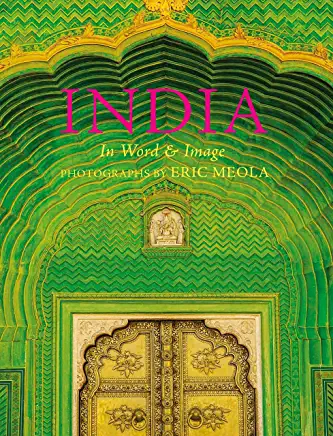

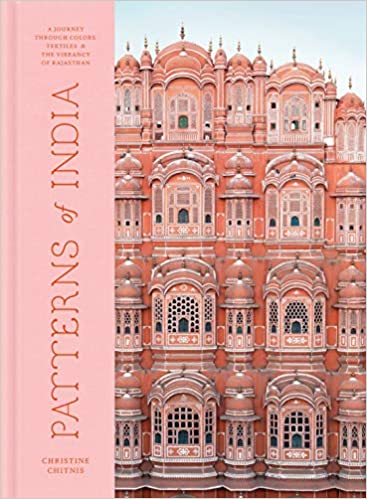
Discover the whispers of the past firsthand
Heritage Sites of India whisper tales of the past, unraveling the rich tapestry of its cultural history. From the golden triangle region of Delhi, Agra, and Jaipur to the magnificent caves, royal palaces, and serene temples, each site carries its own unique story and significance. The Mughal architecture, with its grandeur and opulence, showcases the artistic genius and aesthetic sensibilities of the era. Meanwhile, the rock-cut caves and ancient temples provide glimpses into the religious and spiritual traditions that have shaped the Indian subcontinent. These Heritage Sites of India not only preserve history and culture but also offer visitors a chance to connect with the spirit of the past, immersing themselves in the architectural splendor, historical narratives, and spiritual aura that continues to resonate to this day. Embark on a captivating journey through India’s heritage sites and discover the whispers of the past firsthand.

